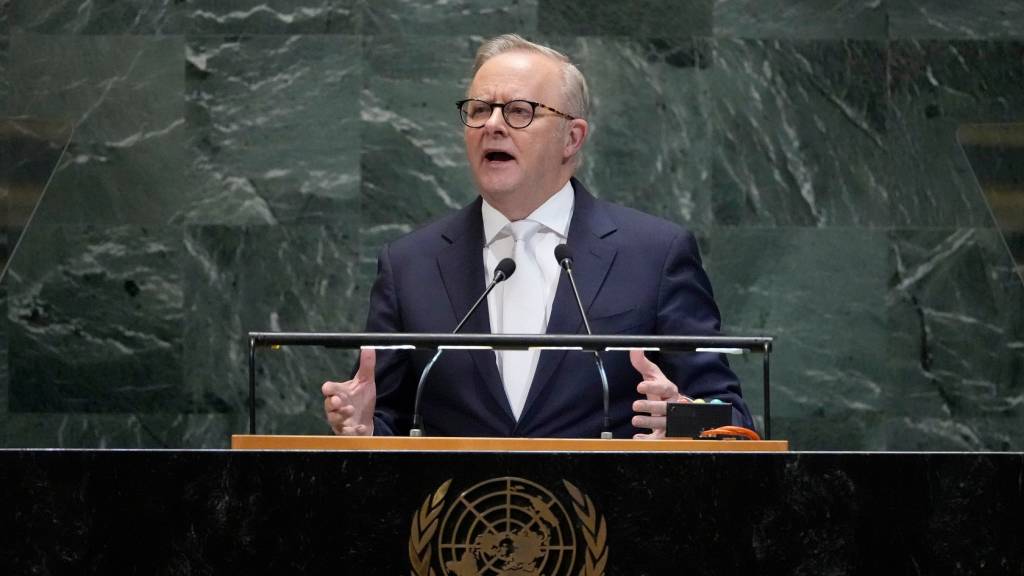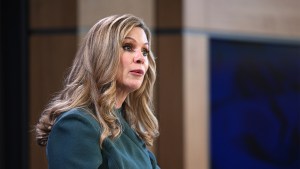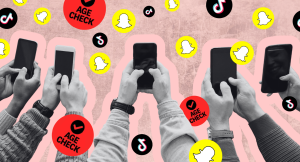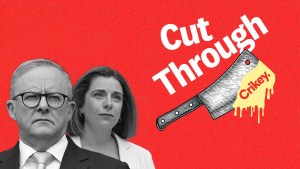By the time you’re reading this, Anthony Albanese will be making his way back from an international trip where he introduced — and celebrated — Australia’s teen social media ban to the world.
Albanese called it a “crucial step in the right direction” in a speech to the UN General Assembly in New York. The prime minister also hosted a UN event during which European Commission President Ursula von der Leyen said she was “inspired” by Australia’s move. The prime minister celebrated the day by ringing the bell at an Australian-themed pub, pouring beers with celebrities and media figures.
You would be forgiven for believing that the Albanese government had already implemented the ban, and it had been a smash hit.
Related Article Block Placeholder
Article ID: 1222777
But there is no ban yet. I don’t just mean that the ban won’t kick in until December 10. What I mean is that the crucial details of the ban — the decisions that decide whether the policy is a success or failure — are still unknown with just two months to go. And that’s shocking for a policy that will literally affect every Australian who goes online, as every user on social media platforms will have to have their age checked by these platforms.
Here are some basic questions that are still unanswered, close to a year and a half after the government first said it would pursue a ban:
Independent. Irreverent. In your inbox
Get the headlines they don’t want you to read. Sign up to Crikey’s free newsletters for fearless reporting, sharp analysis, and a touch of chaos
By continuing, you agree to our Terms & Conditions and Privacy Policy.
Which social media platforms are included in the ban?
We know a handful of major platforms will be banned, including TikTok, Instagram, Snapchat and YouTube (assuming Google doesn’t successfully challenge the YouTube classification as many in the industry speculate it will try). But for the many other platforms that could qualify? No idea!
The ABC reported last week that eSafety commissioner Julie Inman Grant asked 16 companies — including chat application Discord, gaming platform Roblox, programming platform GitHub and Tinder-owner Match — to tell her offices whether they believe the law will apply to them. The eSafety commissioner this week clarified to me that “this request does not mean that they are age-restricted platforms”, and that the office will tell companies and the public about which platforms it expects to be in the ban at some point.
What’s an acceptable number of kids circumventing the ban?
The government has lowered expectations since passing the law, making it clear that it doesn’t expect the law to be completely effective. That’s fine. But for a policy that is supposed to stop kids from peer pressuring other kids to be on social media, how many kids need to use VPNs, fool age-check systems or join non-compliant social media platforms before the policy becomes ineffective?
How good does a platform need to be at detecting teens?
The eSafety commissioner has put out guidelines for the “reasonable expectations” social media companies need to take. But there’s no number (not even a range of numbers, like the government’s climate emissions target range) about how accurate a company’s methods have to be at recognising teens and removing them from their platforms.
What kinds of information are platforms banned from using to check users’ ages?
The law requires the communications minister to seek advice from the privacy commissioner on this topic. According to the commissioner’s office, the minister has yet to do so.
Australia’s approach to ban? You figure it out
Some of these questions are unanswered by design. From the start, the government has always framed this policy as putting the onus on tech companies to figure out the details. It’s common for laws to include general terms like the “reasonable steps” that social media companies need to take, rather than stipulating overly prescriptive requirements which can end up being unenforceable, particularly when it comes to areas with fast-changing technology.
Related Article Block Placeholder
Article ID: 1222522
There’s also some logic to being somewhat vague to keep the companies on their toes. If you set specific benchmarks, you risk companies “teaching to the tests” instead of constantly striving to do whatever is reasonably expected to keep teens off their platforms. For example, if you decide that companies only need to be 80% sure that their users are old enough to be on their platform, then those companies will only ever try to be 80% sure. There’s no incentive to innovate, meaning they won’t dedicate the resources to being 85%, 90%, 99% sure.
Even knowing these reasons, the mushroom approach of keeping everyone in the dark is a bizarre one that threatens the success of the government’s own policy. (This is similar to the approach taken with Labor’s shelved mis/disinformation bill which, perhaps not coincidentally, was also overseen by former communications minister Michelle Rowland.)
The group that the ban will most affect — the million plus Australian teens aged between 13-16 who will soon lose access to these platforms— are, by the government’s own admission, at a vulnerable stage of development. Don’t they deserve to know if the communities they’ve built on platforms like Discord will be banned or not?
Misunderstandings and misinformation about the law are widespread. People are claiming that Github, a platform for storing, sharing and collaborating on software development, will be under the ban (it almost certainly won’t). Others are assuming that everyone will have to upload their government ID, something that is explicitly ruled out in the legislation. It’s a complicated law, to be sure, but it’s not being helped by the slow roll-out of details.
There’s also the people who are responsible for implementing the bans: the people behind these platforms. By the government’s own admission, the government is pioneering a “world-first” policy that — while promising to reel in big tech — also relies on those companies to carry it out.
It’s worth keeping in mind that the broad definition of who falls under the teen social media ban means that all kinds of online platforms may need to be compliant, not just those run by billionaires from Silicon Valley.
There are plenty of small online spaces which are solely or primarily about enabling “online social interaction between two or more end-users” — I’m talking about footy forums, fan Wikis, Mastodon servers and websites that are run by volunteers or on the smell of an oily rag — whose operators now have to figure out how to implement one of these highly technical age checking systems, or live with the fear that they could one day face an enormous fine that would put them out of business. I know this because some of them have told me they’ve frantically been trying to contact people in the government to get basic answers about whether the ban applies to them, only to hear nothing back.
Even if you put those to the side and focus on the biggest players, there are numerous possible consequences from a rushed and ill-informed development that will end up hurting Australian users.
There’s little public sympathy for big tech companies, particularly given their long history of poor behaviour. Sometimes I hear a view expressed by people within the government that complaints about the rushed nature of this process are sour grapes by those who fundamentally oppose the ban to begin with.
Why keeping tech companies in the dark could backfire
Related Article Block Placeholder
Article ID: 1218980
They may be right about bad-faith criticism, but that doesn’t mean there aren’t risks to giving limited information and time to these companies to comply with the law’s requirements. Let’s run through some scenarios about how it could go wrong.
Come December 10, maybe the tech companies’ age checking systems don’t work well. Under 16s are able to sail through age checks that they shouldn’t be able to bypass, while adults are being barred from their accounts, undermining the ban and frustrating others.
Companies over-comply with the law, fearing a potential $50 million fine, and force Australians to go through unnecessarily onerous age-check methods like uploading their government ID (if they have one, which some people don’t). Or they restrict content that should be accessible, such as public health information or news footage, which happened in the UK when it brought in similar laws.
There’s a catastrophic problem, like a data breach of a social media platform that exposes all its users’ information that it wasn’t supposed to keep.
All of these fuck-ups would fundamentally hurt users. Obviously, critics of the ban have been raising these questions for a while, but it’s the proponents who should be really worried that this process is jeopardising the ban’s success. I’m not a political commentator so I’m not going to talk about the blame game, but I believe that the government is failing to give platforms the required information to give them the best chance of implementing the law.
And all of these questions are before we even consider the consequences (both intended and unintended) of the ban once it kicks in.
What happens after the ban?
The eSafety commissioner has tapped academics to review how successful the ban is, but many of the world’s top academics who study the link between social media and children’s well-being (including some who sit on the eSafety commissioner’s advisory group) have argued against Australia’s ban. The science behind raising the age to 16 is at best contested, but that doesn’t seem to be stopping the government’s premature victory lap.
By the government’s own admission, there are downsides to the law even if it works as hoped. “The cost of a regulatory option is any young people under the minimum age would lose access to the connection, community, education and mental health support that social media can offer,” according to the government’s own analysis of the impact of its law. As far as I can tell, the government has spent most of its time talking about the ban and not what it’s doing to help those kids who are losing access.
The eSafety commissioner’s website has some advice for preparing parents for the teen social media ban.
One video features Inman Grant telling parents to “talk openly with family about the restrictions, about how they might be impacted”.
It’s not clear how any parent would do that at this stage, given the paucity of information out there. Perhaps the government could take a break from celebrating and start taking its own advice.




